文章信息
- 李岩, 刘明, 王高鹏, 李刚华, 刘正辉, 唐设, 丁承强, 王绍华, 丁艳锋.
- LI Yan, LIU Ming, WANG Gaopeng, LI Ganghua, LIU Zhenghui, TANG She, DING Chengqiang, WANG Shaohua, DING Yanfeng.
- 营养生长期高温胁迫对水稻生育后期耐冷性的影响
- Effect of high temperature at vegetative stage on chilling tolerance of rice during reproductive period
- 南京农业大学学报, 2016, 39(01): 10-17
- Journal of Nanjing Agricultural University, 2016, 39(01): 10-17.
- http://dx.doi.org/10.7685/jnau.201504048
-
文章历史
- 收稿日期:2015-04-29
随着农村劳动力的减少,机插秧在长江下游稻区开始普及,但由于江苏省的中熟晚粳品种采用小苗机插,收割通常推迟到11月上中旬,生育后期遭遇低温的风险明显增大[1]。低温胁迫下,植物膜质过氧化产物丙二醛大量积累[2, 3],细胞膜系统严重损伤[4],体内叶绿体结构受损,光合速率下降[5, 6]。此外,植物在低温胁迫下对O2-利用能力减弱,多余的O2-被进一步转化成活性氧(active oxygen species,AOS),对细胞膜造成损伤,导致作物减产、品质下降,严重时会造成植株死亡[7]。
姜述君等[8]的研究表明,番茄幼苗经过适宜的低温、高温锻炼均可以提高其耐冷性,且高温锻炼的效果更加明显。马德华等[9]的研究发现低温和高温两种不同的逆境锻炼均能提高黄瓜幼苗在高温条件下的游离态水杨酸(SA)、可溶性蛋白质含量,提高或保持膜保护酶的活性,减轻膜脂过氧化程度,从而增强幼苗对高温的抵抗能力。Shimono等[10, 11]的研究表明水稻营养生长期的温度特别是水温与其生育后期尤其是孕穗期的耐冷性密切相关。Shimono等[12]进行的桶栽试验和田间试验均表明营养生长期高水温(恒温30 ℃)处理后,水稻在孕穗期低温胁迫后的耐冷性显著增强,空壳率降低。以上研究表明,作物在高温环境下生长会对其在另一种逆境中的适应能力产生影响,也就是通常所说的作物交叉适应现象[13]。
但是,以上研究高温处理温度为30 ℃,没有超出水稻营养生长期最适生长温度的范围[14],并且试验地点水稻营养生长期的日均温为19 ℃[12],该地的气温相对偏低。由于全球气候变暖,长江下游水稻营养生长期经常遭遇高温胁迫天气,日最高温度超过35 ℃[15]。为明确营养生长期高温胁迫对水稻后期耐冷性的影响,本试验以耐冷性不同的2个水稻品种为材料,利用人工温室在营养生长期进行加温处理,然后在孕穗期、抽穗期分别进行低温胁迫,分析营养生长期高温胁迫对水稻生育后期耐冷性的影响,以期为长江中下游水稻后期低温冷害减灾避灾技术的研发提供理论指导。
1 材料与方法 1.1 试验材料与设计试验于2014年在南京农业大学牌楼试验基地进行,以耐冷性品种‘宁粳 1号’、冷敏感品种‘扬稻6号’为材料,水稻育秧至3叶1心期移栽至盆里(盆的规格为口径34 cm,底径20 cm,高30 cm,每桶装稻土15 kg),每个处理90 桶,每桶3穴。基肥施用配比如下:每桶施KH2PO4 1.788 g、KCl 0.986 g、尿素1.286 g,保花、促花肥为每桶施尿素1.706 g。移栽后第20~54天,将水稻移入人工温室进行高温处理,同步记录温度(平均增温3~5 ℃,图1),同时在室外设置常温对照(上部用人工温室相同材料遮盖,保证光照一致)。准确记录生育期,至孕穗期(叶龄余数为0至出穗)和抽穗期,处理和对照分别在人工气候室进行低温处理:孕穗期15 ℃处理5 d,抽穗期17 ℃处理7 d。
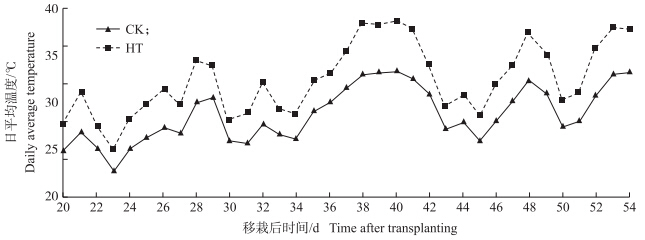 | 图 1 增温处理的日平均温度变化 Fig. 1 Change of the daily average temperature under high temperature treatment HT:高温处理High temperature;CK:常温对照 Normal temperature. The same as below. |
地上部植株烘干粉碎后经浓H2SO4-H2O2消煮,采用凯氏定氮法测定氮含量,钼锑抗比色法测定磷含量[16]。
1.2.2 MDA、可溶性蛋白含量与SOD、POD活性测定[17]低温处理前及处理后1、3和5 d取主茎上三叶并撕除叶脉,置于液氮中待测。SOD 活性采用NBT光化还原法测定,POD活性采用愈创木酚法测定。MDA含量采用TCA-TBA比色法测定。可溶性蛋白含量测定采用考马斯亮蓝法。
1.2.3 花粉不育率的测定取同日开花稻穗中上部颖花5~6个,迅速用卡诺试剂固定,每朵颖花取3个花药捣碎,用I2-KI溶液染色后,在显微镜(NIKON FMZ1500)下随机观察3个视野的染色花粉数和未染色花粉数,计算花粉不育率。
1.2.4 产量及产量结构成熟期考察每穴穗数、穗粒数、结实率、千粒质量,计算单盆产量,各品种、各处理均取3桶作为重复。
1.2.5 数据处理采用Microsoft Excel 2007和SPSS 20.0进行数据处理和方差分析。
2 结果与分析 2.1 增温处理期间的温度变化图1为增温处理期内每日平均温度的变化情况。高温处理的日平均温度明显高于常温对照。常温对照的日平均温度为28.1 ℃,高温处理的日平均温度为32.4 ℃,平均增温4.3 ℃。
对处理期间的最高温度比较发现高温处理的日最高温度明显高于常温对照(图2),高温处理有17 d的日最高温度超过了35 ℃,11 d最高温超过40 ℃。处理的平均日最高温达到了37.2 ℃,对照的平均日最高温则为32.1 ℃。
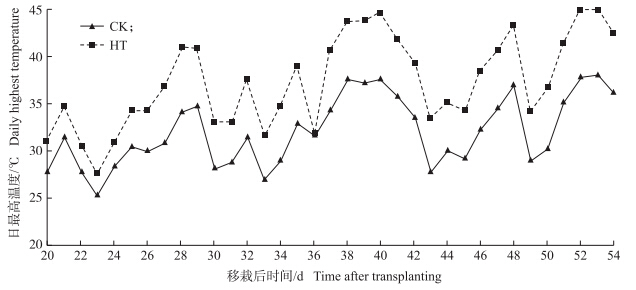 | 图 2 增温处理的日最高温度变化 Fig. 2 Change of daily highest temperature under different temperature treatments |
图3显示:营养生长期高温处理后,两品种地上部植株含氮量(移栽后54 d取样测定)均增加,其中‘宁粳1号’增加0.32%,达到显著水平(P<0.05),‘扬稻6号’增加0.26%。营养生长期高温处理后两品种地上部植株含磷量均降低,其中‘宁粳1号’降低0.02%,‘扬稻6号’降低0.03%,差异均未达到显著水平。
 |
图 3 水稻营养生长期高温处理对植株含氮量(A)和含磷量(B)的影响 Fig. 3 Effect of high temperature during vegetative growth stage on nitrogen(A)and phosphorus(B)content in rice overground organ
NJ1:宁粳 1 号Ningjing 1;YD6:扬稻 6 号 Yangdao 6 不同字母表示在0.05水平差异显著。The different letters mean significant difference at 0.05 level. The same as follows. |
丙二醛(MDA)作为细胞膜脂过氧化程度终产物,在一定程度上能够反映细胞受逆境破坏的程度以及品种的耐冷性。由图4可见:孕穗期、抽穗期低温处理后两品种叶片中MDA含量均呈上升趋势,随着处理时间的延长MDA含量持续增加,冷敏感品种‘扬稻6号’叶片中MDA的含量高于耐冷性品种‘宁粳1号’,上升趋势也是大于‘宁粳1号’。同一品种间,营养生长期高温胁迫,增加了孕穗期、抽穗期低温处理后水稻叶片中MDA含量,随着冷害处理胁迫时间的增加,上升趋势也是更加明显。
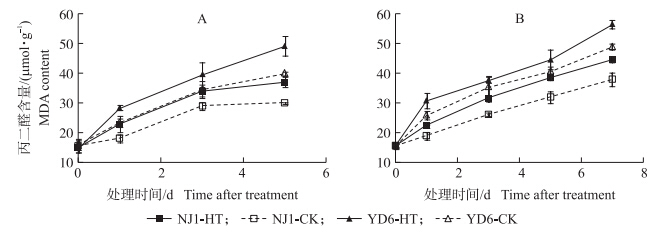 | 图 4 营养生长期高温对孕穗期(A)和抽穗期(B)低温胁迫下水稻叶片中MDA含量的影响 Fig. 4 Effect of high temperature during vegetative growth stage on MDA content in rice leaves under cold stress of booting stage(A)and heading stage(B) |
POD能够及时清除细胞内过氧化物,维持细胞正常代谢。孕穗期、抽穗期进行低温处理的第1天两品种叶片中POD活性即明显增加,随着处理时间的延长POD酶活性持续上升,耐冷性品种‘宁粳1号’叶片中的POD酶活性显著高于冷敏感品种‘扬稻6号’,且上升趋势更加明显。从同一品种来看,高温处理降低了水稻在低温胁迫下POD的活性,抑制了POD活性的上升趋势(图5)。
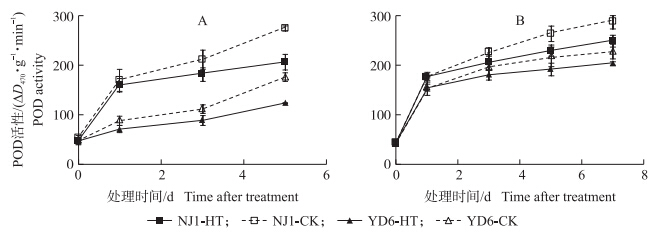 | 图 5 养生长期高温对孕穗期(A)和抽穗期(B)低温胁迫下水稻叶片中POD活性的影响 Fig. 5 Effect of high temperature during vegetative growth stage on POD activity in rice leaves under cold stress of booting stage(A)and heading stage(B) |
图6显示:孕穗期、抽穗期低温胁迫的第1天两品种叶片中SOD活性明显增加,随着处理时间的延长SOD活性持续上升,耐冷性品种‘宁粳1号’SOD的活性明显高于冷敏感品种‘扬稻6号’,低温胁迫下上升幅度更大。同一品种水稻在低温胁迫下的SOD活性较低,表明高温处理抑制了了SOD活性的上升趋势。
 | 图 6 营养生长期高温对孕穗期(A)和抽穗期(B)低温胁迫下水稻叶片中SOD活性的影响 Fig. 6 Effect of high temperature during vegetative growth stage on SOD activity in rice leaves under cold stress of booting stage(A)and heading stage(B) |
可溶性蛋白含量能够反映作物在逆境条件下细渗透势的变化[18]。由图7可见:孕穗期、抽穗期低温处理后两品种叶片中可溶性蛋白含量明显增加,随处理时间的延长持续增加,冷敏感品种‘扬稻6号’叶片中可溶性蛋白含量低于耐冷性品种‘宁粳1号’,上升趋势也小于‘宁粳1号’。同一品种高温处理延缓了水稻叶片中可溶性蛋白含量的上升趋势。
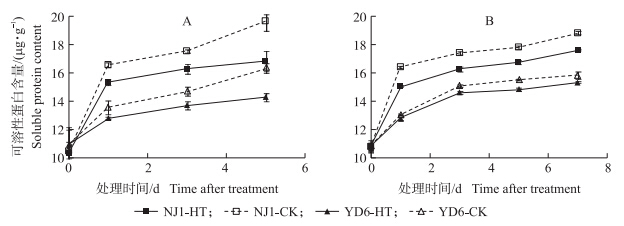 | 图 7 营养生长期高温对孕穗期(A)和抽穗期(B)低温胁迫下水稻叶片中可溶性蛋白含量的影响 Fig. 7 Effect of high temperature during vegetative growth stage on soluble protein content in rice leaves under cold stress of booting stage(A)and heading stage(B) |
图8显示:孕穗期、抽穗期低温胁迫后,两品种的花粉不育率升高,冷敏感品种‘扬稻6号’受低温影响更加明显,各处理的花粉不育率均明显高于‘宁粳1号’。经营养生长期高温处理,‘宁粳1号’在孕穗期、抽穗期低温胁迫后的花粉不育率分别增加14.3%和16.9%,‘扬稻6号’在孕穗期、抽穗期低温胁迫后的花粉不育率分别增加20%和16%,二者均达显著水平。
 | 图 8 水稻营养生长期高温处理对孕穗期(A)和抽穗期(B)低温胁迫后水稻花粉不育率的影响 Fig. 8 Effect of high temperature during vegetative growth stage on pollen fertility rate under cold stress of booting stage(A)and heading stage(B) |
由表1可见:营养生长期高温胁迫后,两品种在孕穗期低温胁迫后结实率均明显降低,其中冷敏感品种‘扬稻6号’降低了14.1%,达到了显著水平;‘扬稻6号’穗粒数减少但未达到显著差异水平;‘宁粳1号’穗粒数无明显变化;两品种千粒质量均没有明显变化;产量均下降,其中‘扬稻6号’每盆下降16.6 g,达到了显著水平。
| 品种 Varieties |
处理 Treatments |
每盆穂数 Panicles per pot |
穗粒数 Spikelets per panicle |
结实率/% Seed-setting rate |
千粒质量/g 1000-grain weight |
每盆产量/g Yield per pot |
| 宁粳1号 | HT | 22.0 | 147.1 | 78.8b | 23.4 | 59.7a |
| NJ1 | CK | 23.3 | 143.6 | 88.9a | 23.5 | 69.3a |
| 扬稻6号 | HT | 20.7 | 144.1 | 49.5b | 23.6 | 41.2b |
| YD6 | CK | 19.3 | 163.7 | 63.6a | 23.7 | 57.8a |
| 效应 Effect | ||||||
| V | 2.5 | 3.0 | 214.8** | 2.6 | 8.6* | |
| N | 0.0 | 2.7 | 22.2** | 1.9 | 15.1** | |
| V×N | 0.6 | 5.4* | 4.8 | 3.0 | 0.7 | |
|
注:1)数据后不同小写字母表示在0.05水平上差异显著。Different letters after data denote significant differences at 0.05 probability level. The same as below. 2)V:品种Variety,N:处理Treatment;*P < 0.05,**P < 0.01. |
||||||
表2显示:经营养生长期高温处理,两品种在抽穗期低温胁迫后结实率均显著降低,‘宁粳1号’降低了17.7%,‘扬稻6号’降低了15.6%;穗粒数显著降低,‘宁粳1号’降低了23.8,‘扬稻6号’降低了39.9;结实率显著下降,‘宁粳1号’降低了7.7%,‘扬稻6号’降低了15.6%;千粒质量没有明显变化;产量均显著降低,‘宁粳1号’每盆减产15.3 g,‘扬稻6号’每盆减产24.2 g。
| 品种 Varieties |
处理 Treatments |
每盆穂数 Panicles per pot |
穗粒数 Spikelets per panicle |
结实率/% Seed-setting rate |
千粒质量/g 1000-grain weight |
每盆产量/g Yield per pot |
| 宁粳1号 | HT | 18.7 | 155.3b | 76.9b | 23.8 | 53.2b |
| NJ1 | CK | 19.0 | 179.1a | 84.6a | 23.8 | 68.5a |
| 扬稻6号 | HT | 18.0 | 144.1b | 42.9b | 28.3 | 31.5b |
| YD6 | CK | 18.3 | 184.0a | 58.5a | 28.3 | 55.7a |
| 效应 Effect | ||||||
| V | 2.5 | 3.0 | 214.8** | 262.6** | 8.6* | |
| N | 0.0 | 20.1** | 22.2** | 1.9 | 18.5** | |
| V×N | 0.6 | 5.4* | 4.8 | 3.0 | 0.7 | |
MDA是细胞膜脂过氧化作用的产物之一,植物的受伤害程度可以通过MDA的含量来衡量[19]。李霞等[20]的研究认为,与不耐冷品种相比,耐冷性品种在低温胁迫下过氧化产物MDA积累较少。王国骄等[21]的研究认为孕穗期和抽穗期低温胁迫下冷敏感品种剑叶的SOD、POD活性显著升高,强耐冷性品种SOD、POD的活性极显著升高。本研究中,低温胁迫下‘宁粳1号’SOD、POD活性高于‘扬稻6号’,MDA积累量低于‘扬稻6号’,这与文献报道结果[20, 21]一致。
植物对氮素的吸收与环境条件密切相关。Ma等[22]研究表明气温升高会加快土壤中氮素的循环过程,土壤中可供植物吸收利用的氮素总量升高,进而提高了土壤中氮素的供应能力,有利于植物对氮素的吸收利用。Yuan等[23]研究表明增温处理后植株地上部氮素积累量升高。Cheng等[24]认为气温升高时植物可以吸收积累更多的氮素以用于物质生产,从而增强了单位土地面积的干物质生产能力,同时气温升高也可能促进植物对氮素的利用效率。在本文的研究中,增温处理后,两品种植株含氮量均高于常温对照,这与以上的研究结果[23, 24, 25]一致。
高温热害会对水稻的结实率产生严重的影响。孙正玉等[25]的研究表明,夏季高温会导致水稻颖花的大量退化和不育,增加空秕率,降低结实率从而引起严重的减产。许传桢等[26]的研究发现,天然高温对杂交稻结实率的影响主要是影响授粉受精,从而增加空壳率,降低结实率,并扰乱穗部枝梗上颖花的开花顺序及结实率的分布规律。在本研究中,经营养生长期高温处理,水稻在低温胁迫后花粉活力和结实率的降低幅度更大,结实率的降低是引起减产的主因,因此营养生长期高温热害是引起水稻减产的主要因子之一,这与前人的研究结果基本一致。
水稻营养生长期最适生长温度为25~30 ℃[14],当日平均温度在30 ℃以上,日最高气温大于35 ℃时便形成高温热害[27]。水稻营养生长期的温度条件与其生育后期的耐冷能力密切相关[28]。Gong等[13]的研究表明,水稻营养生长期高水温处理(恒温30 ℃)较于正常水温(19 ℃),其孕穗期的抗冷能力明显增强。但这些研究的温度处理都在水稻生长的适宜范围。本文的研究表明营养生长期增温处理(日均温32.4 ℃,绝大多数日最高气温超过35 ℃,部分天数日最高气温达到40 ℃以上)后水稻生育后期的耐冷性降低。Shimono等[12]试验结果显示,高水温条件与水稻最适生长温度基本一致,而在本文的研究中,增温处理后,由于温度太高已经形成了热害,因此二者的研究结果完全相反。
高氮不利于水稻耐冷,而增施磷肥能够提高水稻的耐冷性[29],因此在生产中通常采用减氮增磷的方式抵御低温冷害[30]。本研究中,营养生长期高温胁迫可能提高了氮含量降低了磷含量,因而降低了水稻抵御冷害的能力。在实际生产中,可以通过水肥的调控及微量元素的施用来抵御低温冷害。王士强[31]的研究表明,对于高氮引起的贪青不耐冷,可以通过施用钾肥减免。侯立刚[30]认为增施磷肥可以增加水稻体内可溶性糖的含量,降低了细胞原生质冰点,从而达到抵御低温的效果。邢精贵等[32]的研究表明,孕穗期冷害会导致抽穗延迟,可在剑叶抽出时喷施磷酸二氢钾。施用有机肥能够改良土壤,保温土层,促进水稻对磷钾的吸收[33]。水稻孕穗期深水灌溉15~20 cm,能够有效的抵御低温[34]。
| [1] | 孙富,杨丽涛,谢晓娜,等. 低温胁迫对不同抗寒性甘蔗品种幼苗叶绿体生理代谢的影响[J]. 作物学报,2012,38(4):732-739. Sun F,Yang L T,Xie X N,et al. Effect of chilling stress on physiological metabolism in chloroplasts of seed-lings of sugarcane varieties with different chilling resistance[J]. Acta Agronomica Sinica,2012,38(4):732-739(in Chinese with English abstract). |
| [2] | 韩龙植,乔永利,张媛媛,等. 水稻孕穗期耐冷性QTLs分析[J]. 作物学报,2005,31(5):653-657. Han L Z,Qiao Y L,Zhang Y Y,et al. Identification of QTLs for cold tolerance at the booting stage in rice[J]. Acta Agronomica Sinica,2005,31(5):653-657(in Chinese with English abstract). |
| [3] | 邓化冰,车芳璐,肖应辉,等. 开花期低温胁迫对水稻花粉性状及剑叶理化特性的影响[J]. 应用生态学报,2011,22(1):66-72. Deng H B,Che F L,Xiao Y H,et al. Effects of low temperature stress during flowering period on pollen characters and flag leaf physiological and biochemical characteristics of rice[J]. Chinese Journal of Applied Ecology,2011,22(1):66-72(in Chinese with English abstract). |
| [4] | 戴陆园,林兴华,叶昌荣,等. 水稻耐冷性研究:Ⅲ. 特定颖花结实率作为耐冷性指标的分子依据[J]. 作物学报,2003,29(5):708-714. Dai L Y,Lin X H,Ye C R,et al. Studies on cold tolerance of rice,Oryza sativa L.:Ⅲ. Molecular basis for special fertility percentage as evaluation increterior of cold toleance[J]. Acta Agronomica Sinica,2003,29(5):708-714(in Chinese with English abstract). |
| [5] | 吴广霞,唐献龙,杨德光,等. 植物低温胁迫生理研究进展[J]. 作物杂志,2008(3):17-19. Wu G X,Tang X L,Yang D G,et al. Research progress on physiology of plant cold hardiness[J]. Crops,2008(3):17-19(in Chinese with English abstract). |
| [6] | 刘贞琦,刘振业,马达鹏,等. 水稻叶绿素含量及其与光合速率关系的研究[J]. 作物学报,1984,10(1):57-62. Liu Z Q,Liu Z Y,Ma D P,et al. A study on the relation between chlorophyll content and photosynthetic rate of rice[J]. Acta Agronomica Sinica,1984,10(1):57-62(in Chinese with English abstract). |
| [7] | 王萍,张成军,陈国祥,等. 低温对水稻剑叶膜脂过氧化和脂肪酸组分的影响[J]. 作物学报,2006,32(4):568-572. Wang P,Zhang C J,Chen G X,et al. Effects of low temperature on lipid peroxidation and fatty acid composition of flag leaf in rice(Oryza sativa L.)[J]. Acta Agronomica Sinica,2006,32(4):568-572(in Chinese with English abstract). |
| [8] | 姜述君,常缨,范文艳,等. 温度逆境锻炼对低温胁迫下番茄幼苗细胞膜脂质过氧化产物及抗氧化酶活性的影响[J]. 中国农学通报,2007,23(10):444-448. Jiang S J,Chang Y,Fan W Y,et al. Effects of temperature stress acclimation on peroxidation product of membranein lipids and anti-oxidative enzyme activities of tomato seedling under cold stress[J]. Chinese Agricultural Science Bulletin,2007,23(10):444-448(in Chinese with English abstract). |
| [9] | 马德华,庞金安,李淑菊,等. 温度逆境锻炼对高温下黄瓜幼苗生理的影响[J]. 园艺学报,1998,25(4):350-355. Ma D H,Pang J A,Li S J,et al. Effects of temperature stress acclimation on physiological changes of cucumber seedling under high temperature stress[J]. Acta Horticulturae Sinica,1998,25(4):350-355(in Chinese with English abstract). |
| [10] | Shimono H,Kanda E. Does regional temperature difference before the panicle initiation affect the tolerance for low temperature-induced sterility in rice?[J]. Plant Production Science,2008,11(4):430-433. |
| [11] | Shimono H,Okada M,Kanda E,et al. Low temperature-induced sterility in rice:evidence for the effects of temperature before panicle initiation[J]. Field Crops Research,2007,101(2):221-231. |
| [12] | Shimono H,Suto M,Nagano K. Cold tolerance for sterility induced by low temperature at booting stage can be improved by warmer water temperature during vegetative growth[J]. Climate in Biosphere,2012,12:1-5. |
| [13] | Gong M,Chen B O,Li Z G,et al. Heat-shock-induced cross adaptation to heat,chilling,drought and salt stress in maize seedlings and involvement of H2O2[J]. Journal of Plant Physiology,2001,158(9):1125-1130. |
| [14] | 刘桃菊,殷新佑,戚昌瀚,等. 气候变化与水稻生长发育及产量形成关系的模拟研究[J]. 应用生态学报,2005,16(3):486-490. Liu T J,Yin X Y,Qi C H,et al. Relationships between climate change and rice development and its yield formation:a simulation study[J]. Chinese Journal of Applied Ecology,2005,16(3):486-490(in Chinese with English abstract). |
| [15] | 谢晓金,李秉柏,王琳,等. 长江中下游地区高温时空分布及水稻花期的避害对策[J]. 中国农业气象,2010,31(1):144-150. Xie X J,Li B B,Wang L,et al. Spatial and temporal distribution of high temperature and strategies to rice florescence harm in the lower-middle reaches of yangtze river[J]. Chinese Journal of Agrometeorology,2010,31(1):144-150(in Chinese with English abstract). |
| [16] | 鲁如坤. 土壤农业化学分析方法[M]. 北京:中国农业科技出版社,2000:309-316. Lu R K. Agricultural Chemical Analysis Method of Soil[M]. Beijing:China Agricultural Science and Technology Press,2000:309-316(in Chinese). |
| [17] | 王学奎. 植物生理生化试验原理和技术[M]. 北京:高等教育出版社,2005:170-195. Wang X K. Plant Physiology and Biochemistry Test Principles and Techniques[M]. Beijing:High Education Press,2005:170-195(in Chinese). |
| [18] | Gill S S,Tuteja N. Reactive oxygen species and antioxidant machinery in abiotic stress tolerance in crop plants[J]. Plant Physiology and Biochemistry,2010,48(12):909-930. |
| [19] | Liu J J,Lin S H,Xu P L,et al. Effects of exogenous silicon on the activities of antioxidant enzymes and lipid peroxidation in chilling-stressed cucumber leaves[J]. Agricultural Sciences in China,2009,8(9):1075-1086. |
| [20] | 李霞,戴传超,程睿,等. 不同生育期水稻耐冷性的鉴定及耐冷性差异的生理机制[J]. 作物学报,2006,32(1):76-83. Li X,Dai C C,Cheng R,et al. Identification for cold tolerance at different growth stages in rice(Oryza sativa L.)and pysiological mchanism of dfferential cld tlerance[J]. Acta Agronomica Sinica,2006,32(1):76-83(in Chinese with English abstract). |
| [21] | 王国骄,王嘉宇,苗微,等. 强耐冷性水稻新品系J07-23抗氧化系统对长期冷水胁迫的响应[J]. 作物学报,2013,39(4):753-759. Wang G J,Wang J Y,Miao W,et al. Responses of antioxidant system to long-term cold water stress in new rice line J07-23 with strong cold tolerance[J]. Acta Agronomica Sinica,2013,39(4):753-759(in Chinese with English abstract). |
| [22] | Ma L N,Lü X T,Liu Y,et al. The effects of warming and nitrogen addition on soil nitrogen cycling in a temperate grassland,northeastern China[J]. PLoS ONE,2011,6(11):e27645. |
| [23] | Yuan A,Wan S Q,Zhou X H,et al. Plant nitrogen concentration,use efficiency,and contents in a tallgrass prairie ecosystem under experimental warming[J]. Global Change Biology,2005,11(10):1733-1744. |
| [24] | Cheng W G,Hasegawa T,Sakai H,et al. Combined effects of elevated[CO2]and high night temperature on carbon assimilation,nitrogen absorption,and the allocations of C and N by rice(Oryza sativa L.)[J]. Agricultural and Forest Meteorology,2010,150(9):1174-1181. |
| [25] | 孙正玉,霍金兰,孙明,等. 2013年夏季高温对盐城水稻生产的影响[J]. 大麦与谷类科学,2014(3):12-14. Sun Z Y,Huo J L,Sun M,et al. The effect of summer high temperature on rice production in Yancheng 2013[J]. Barley and Cereal Science,2014(3):12-14(in Chinese). |
| [26] | 许传桢,元生朝,蔡士玉. 高温对杂交水稻结实率的影响[J]. 华中农学院学报,1982(2):1-8. Xu C Z,Yuan S Z,Cai S Y. The Effect of high temperature on hybrid rice seed rate[J]. Journal of Huazhong Agricultural College,1982(2):1-8(in Chinese). |
| [27] | 山西气象局. 山西天气预报手册[M]. 北京:气象出版社1987:44-46. Shanxi Meteorological Bureau. Shanxi Weather Forecast Manual[M]. Beijing:Meteorological Press,1987:44-46(in Chinese). |
| [28] | Ye C,Fukai S,Godwin I D,et al. A QTL controlling low temperature induced spikelet sterility at booting stage in rice[J]. Euphytica,2010,176(3):291-301. |
| [29] | 商全玉. 减氮增磷施肥技术对高寒地区水稻产量及物质积累的影响[J]. 中国稻米,2013,19(5):81-83. Shang Q Y. The effect on rice in cold region yield and dry matter accumulation of reduced nitrogen and increased phosphorus fertilization[J]. China Rice,2013,19(5):81-83(in Chinese). |
| [30] | 侯立刚. 磷对东北粳稻耐冷性及产量和品质的影响[D]. 沈阳:沈阳农业大学,2012:85-90. Hou L G. Effects of different phosphate fertilizer application on the characteristics of cold tolerance physiology,yield and quality in northeastern japonica rice[D]. Shenyang:Shenyang Agricultural University,2012:85-90(in Chinese with English abstract). |
| [31] | 王士强. 防御寒地水稻冷害的施肥技术研究现状[J]. 北方水稻,2009,39(5):77-80. Wang S Q. Research advances on fertilization techniques against cold injuryto rice in cold regions[J]. North Rice,2009,39(5):77-80(in Chinese with English abstract). |
| [32] | 邢精贵,赵金满,唐德富. 2002年低温冷害对水稻生育的影响及防御对策[J]. 植保技术与推广,2003,23(5):16-17. Xing J G,Zhao J M,Tang D F. The cold damage on rice growth and defensive measures in 2002[J]. Plant Protection Technology and Extension,2003,23(5):16-17(in Chinese). |
| [33] | Janowiak F,Maas B,Dörffling K. Importance of abscisic acid for chilling tolerance of maize seedlings[J]. Journal of Plant Physiology,2002,159(6):635-643. |
| [34] | 徐奎彻,姜妙男,朴春会,等. 水稻障碍型冷害的前历深水效果[J]. 延边农学院学报,1993,15(3):163-169,179. Xu K C,Jiang M N,Pu C H,et al. Rice obstacle before calendar cool injury deepwater effect[J]. Journal of Yanbian Agricultural College,1993,15(3):163-169,179(in Chinese with English abstract). |




